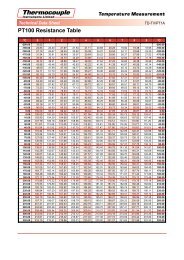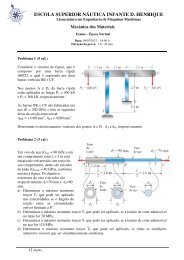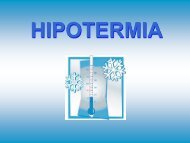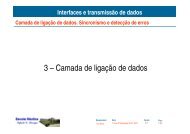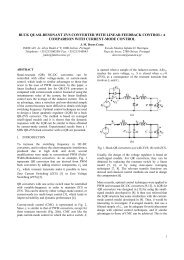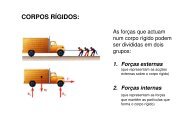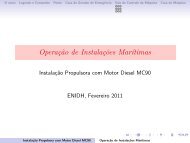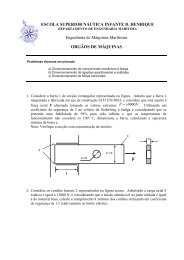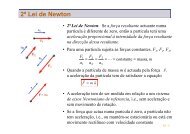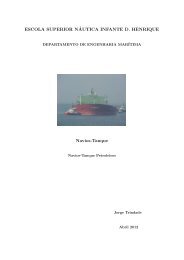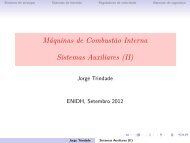Textos de Apoio (pdf)
Textos de Apoio (pdf)
Textos de Apoio (pdf)
Create successful ePaper yourself
Turn your PDF publications into a flip-book with our unique Google optimized e-Paper software.
ITTC – Recommen<strong>de</strong>d<br />
7.5-04<br />
-01-01.1<br />
Procedures and Gui<strong>de</strong>lines Page 8 of 10<br />
Full Scale Measurements<br />
Speed and Power Trials<br />
Preparation and Conduct of<br />
Speed/Power Trials<br />
Effective Date<br />
2005<br />
Revision<br />
03<br />
In accordance with ISO 15016 the following,<br />
general recommendations can be given:<br />
4.5.1 Wind:<br />
Wind speed and direction shall be measured<br />
as relative wind; continuous recording of relative<br />
wind during each run is recommen<strong>de</strong>d.<br />
Care has to be taken whether the data <strong>de</strong>rived<br />
from the wind indicator are reliable; checks,<br />
such as parallel measurements with a portable<br />
instrument, comparison of the data received<br />
from the wind indicator with wind speeds and<br />
directions received from local weather stations<br />
sufficiently close to the actual position of the<br />
ship or, if possible, calibration of the wind indicator<br />
(taking into consi<strong>de</strong>ration the effects of<br />
boundary layers of the superstructure on the<br />
measured values) in a wind tunnel are recommen<strong>de</strong>d.<br />
It is suggested that wind force during the<br />
trial runs un<strong>de</strong>r no conditions should be higher<br />
than<br />
• Beaufort 6 for ships with lengths equal<br />
or exceeding 100m and<br />
• Beaufort 5 for ships shorter than 100m.<br />
4.5.2 Sea State:<br />
If possible, instruments such as buoys or instruments<br />
onboard ships (e.g. seaway analysis<br />
radar) should be used to <strong>de</strong>termine the wave<br />
height, wave period and direction of seas and<br />
swell. Consi<strong>de</strong>ring usual practice the wave<br />
heights may be <strong>de</strong>termined from observations<br />
by multiple, experienced observers, including<br />
the nautical staff on board.<br />
During the trial runs the total wave height<br />
(double amplitu<strong>de</strong>), which allows for the wave<br />
heights of seas and swell (see ISO 15016),<br />
should not exceed<br />
• 3m for ships of 100m length and more<br />
and<br />
• 1,5m for ships with lengths smaller than<br />
100m<br />
4.5.3 Current:<br />
Current speed and direction shall be obtained<br />
either as part of the evaluation of run<br />
and counter-run of each double run, by direct<br />
measurement with a current gauge buoy or by<br />
use of nautical charts of the respective trial area.<br />
It is recommen<strong>de</strong>d to compare measured data<br />
with those inclu<strong>de</strong>d on the nautical charts.<br />
4.6 Trial Conduct:<br />
All speed trials shall be carried out using<br />
double runs, i.e. each run is followed by a return<br />
run in the opposite direction, performed<br />
with the same engine settings.<br />
The number of such double runs should not<br />
be less than three. This three runs should be at<br />
different engine settings.<br />
The time necessary for a speed run <strong>de</strong>pends<br />
on the ship’s speed, size and power. Steady<br />
state conditions should be achieved before the<br />
speed runs start. It is recommen<strong>de</strong>d that the<br />
time of one run should be as long as possible<br />
but should at least be 10 min.<br />
The i<strong>de</strong>al path of a ship in a typical<br />
speed/power maneuver is shown in Figure 1:


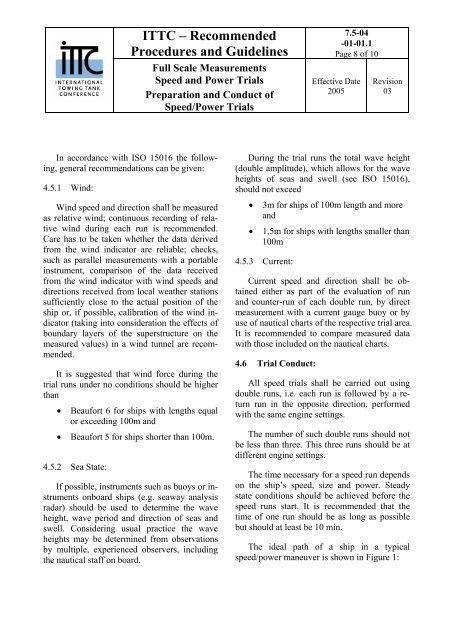
![Conceitos transmissao de dados .Sinais[.pdf]](https://img.yumpu.com/50982145/1/190x146/conceitos-transmissao-de-dados-sinaispdf.jpg?quality=85)
![Packages e interfaces[.pdf]](https://img.yumpu.com/50629553/1/190x134/packages-e-interfacespdf.jpg?quality=85)
